Learn how to spot fake Peter Max artwork with these seven key checks—style, signature, provenance, materials, and price—so you can collect with confidence.
How to Spot Fake Peter Max Artwork
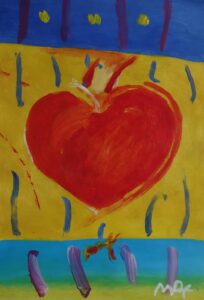
This looks like a kindergarten class had a Peter Max appreciation day. Yes, at the time of this publication it was being claimed as an authentic painting signed by Peter Max.
Art forgery has plagued collectors and enthusiasts for centuries, with counterfeit works appearing in auction houses, galleries, and online marketplaces. Among the many victims of this deceptive practice, renowned pop artist Peter Max has become a prime target. Known for his vibrant, psychedelic imagery and cultural significance, Max’s works are highly sought after by collectors, making them an appealing focus for forgers.
One of the most infamous cases of Peter Max forgery involved Nicholas P. Hatch, who orchestrated the sale of 145 fraudulent Peter Max paintings. This case exemplifies how forgers exploit the demand for Max’s art, deceiving unsuspecting buyers and tarnishing the artist’s legacy. Moreover, online platforms such as eBay have become notorious breeding grounds for fake Peter Max paintings, many of which originate from sellers in foreign countries like Peru and Austria. These knockoffs, often priced at under $300, are poorly executed imitations that fail to capture Max’s signature style. Similarly, platforms like Etsy also host counterfeit Peter Max works, though to a lesser extent.
Since Peter Max stopped painting in 2012, no paintings can be considered new. However, prints can be new, and fakes also happen with them. Along with many sites, Redbubble.com is rife with unauthorized reproductions of Peter Max’s iconic postcards, printed and sold without the artist’s consent. These forgeries (copies) deceive buyers and diminish the value of authentic Peter Max pieces.
As a collector or fan of Peter Max’s work, understanding how to distinguish genuine pieces from counterfeits is crucial. This article will provide 7 Ways to Spot a Peter Max Fake, giving you the basics of what to look for to avoid fraudulent paintings and giving you an appreciation for this iconic artist’s authentic brilliance.
1. Familiarize Yourself with Max’s Style and Common Elements
Peter Max’s work is distinct. It often features themes like cosmic landscapes, the Statue of Liberty, and patriotic symbols, all rendered with bright, bold colors. His brushstrokes are energetic and loose, giving a sense of movement and spontaneity. When viewing a potential piece, check if the work aligns with these themes, colors, and brush techniques. It may be a forgery if the artwork seems overly stiff, or the colors lack vibrancy.
Max’s signature elements include:
- Cosmic Imagery: Stars, planets, and celestial forms.
- Statue of Liberty Series: Many works focus on this American icon.
- Patriotic Themes: American flags and patriotic colors.
- Loose Brushwork: A unique, fluid brushstroke style.
- High Saturation: His colors are bold, with slight dullness.
Peter Max often paints the same paintings and images with slight variations and coloring. Chances are the painting you are interested in has been painted by Peter Max before. You must search for “known” works of the same image and compare the two. The comparison will provide you with great insight into what a “real” Peter Max should look like. If you can find any major price discrepancies, that would be another indicator that it’s likely a fake.
PETER MAX PAINTINGS SELLING PRICE GUIDELINE
Peter Max’s artwork can vary widely in price depending on factors such as the medium, edition size, subject matter, and overall condition. Original paintings on canvas—particularly those featuring iconic imagery like Lady Liberty or his signature “Cosmic” themes—tend to command the highest prices, often ranging from around $10,000 to over $50,000 at auction.
Mixed-media works, typically prints or serigraphs that Max has hand-embellished with paint, usually sell in the mid-range: for instance, a mixed-media “Flag with Heart” piece might sell for $3,000–$10,000.
Limited edition prints, numbered and signed by Max, can fetch several hundred to a few thousand dollars, depending on rarity and demand—for example, a numbered “Umbrella Man” print might go for $1,000–$2,500.
Open edition prints, which are not numbered, generally represent the most affordable tier, often selling below $1,000. Examples of recent sales include an original acrylic on canvas, “Liberty Head,” that sold for around $15,000 at Heritage Auctions in 2016, while a mixed media “Better World” piece went for approximately $3,500, illustrating the broad range of values across Max’s oeuvre.
Note that due to health issues Peter Max has not been painting since around 2012.
Examples from MacDonald Gallery see: Peter Max Artwork For Sale.
2. Inspect the Signature Carefully
Peter Max signs each of his works, but forgers often attempt to replicate it. A genuine Peter Max signature is typically bold and fluid, harmonizing with the painting’s overall style, and often executed in colors that match the artwork. When examining the signature, look for placement, style, and line quality inconsistencies. A shaky or uneven signature may indicate a forgery.
For signed prints, it’s essential to inspect the signature close-up. Use a jeweler’s loupe to check for imperfections, such as tiny dot patterns (known as a screen in printing) that suggest the signature was part of the printing process rather than hand-signed. Magnification is crucial because these dots may be tiny and invisible to the naked eye. Even for hand-painted works, examining the signature through a loupe can reveal telltale inconsistencies or irregularities that could signify a forgery. Always approach signatures with a critical eye and verify their authenticity alongside other artwork elements.
Peter Max Signature Evaluations

This is an authentic signature in pencil. There was a time when he used his first name in his signature.
Note his very common use of several colors in his signature, which flow along the contour in the form of the letters. Max usually makes three humps to his “M,” with the last hump becoming an “A” with the “X” crossing through it. You can see that the part of the “X” used in the “A” is under the last stroke of the “X.”
LEFT (Above):The signature on the left is a good attempt, but it should jump out at you because the bar of the “X” crossing the “A” was done after the other bar of the “X.” You can see it is on top, meaning it (the down stroke of the “X”) was painted first – not last like Max. Overall, the signature appears ugly. Peter Max’s signatures always look as beautiful as the painting itself.
RIGHT (Above): Another comparison. Even though the bar in the “X” completing the “A” was painted in order because it is under the last stroke, the flow of paint is even worse than the one on the left. Referring back to key number 1, it should not be too difficult to see the image is not painted with Max’s precision and touch. It reeks of an amateurish application of paint and color harmony.
This is a terrible attempt at “faking” his signature. The humps in the “M” do not flow. You can see that the “A” was started separately. There is an attempt to use the “X” in the formation of the “A.” It should stick out that the signature is all one color and has a washed look.
There are no indications of a screen pattern (but it must be verified close up with a loupe). The signature appears to flow. The upstroke on the “M” is lighter and darkens as it comes down when more pressure is applied. The other letters seem to flow. But what comes out even before all these details is the signature “Max.” Each letter was written separately, which creates doubt about authenticity. However, Max is known to have occasionally written his signature with separate letters. If everything else is checked out, including the appearance of the artwork and the provenance checks out, then it would be prudent to have further due diligence done on signature authentication.
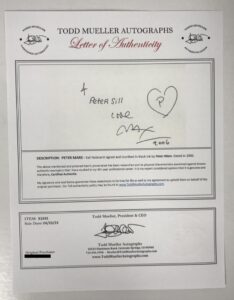
If the signature looks appropriate, another step is to have it certified by a reputable authenticator.
OUR REAL LIFE EXPERIENCE with “If”
We came across a dream opportunity with an artist proof of “If” by Peter Max. It was too good to be accurate as it was 1/200 (the first of a limited edition of 200). The lower the number of limited editions, the higher the value. In communicating with the seller, he guaranteed it was authentic and signed. It would be a great piece for our resident Peter Max collection. One last clarification from the seller was that Max had signed it in pencil. The signature and markings from the picture looked as good as they could be. We bought it!
After receiving it, everything looked good at first glance. We were so excited! Next, we did our own authentication. We knew the appearance of the signature in pencil looked right, but we needed to be sure. We have a microscope camera, and low and behold, those “screen dots” showed up in the signature. Talk about making our hearts sink.
To figure out what this artwork was, we did an in-depth search of as many “If” print images as we could find. Then we hit upon the same one, complete with the identical pencil writings “1/200” and Peter Max’s signature, etc. Even though we knew when we saw the “screen dots ” that the print wasn’t really hand signed in pencil, we satisfied our curiosity of where the print originated.
Lastly, we fell victim to wanting to believe it was really signed by Peter Max, because it wasn’t as vibrant and color saturated as it should have been which really stood out once reality set in.
When we contacted the seller with our findings, he had no choice but to accept the return of the print and refund our money or face some very serious fraud charges.
We thought the seller believed he had the real thing and just got taken by someone.
“If” only it had been real…. pun intended. lol
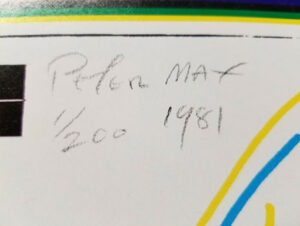
This was all we could see of the pencil markings, which appeared very authentic because they were, just not in the original pencil.
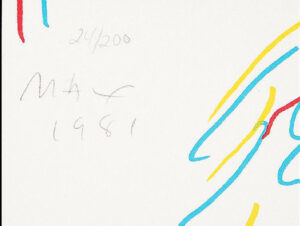
Before committing to the purchase, we tried to enlarge these pictures to examine for “screen dots,” but they became too blurry to tell. We reconfirmed with the seller that the pencil writings were genuine.
3. Check the Provenance and Authenticity Documentation
One of the most critical steps in verifying the authenticity of a Peter Max painting is to examine its provenance and documentation. Since Peter Max is no longer producing artwork, many forgers exploit this by selling “preowned” pieces that are intentionally aged to appear legitimate. This includes artificially weathering canvases, papers, frames, and even markings on the back of the painting to give the illusion of age and authenticity.
Be aware that provenance documentation, including Certificates of Authenticity (COAs), can also be faked. Forgers may create convincing replicas of gallery stamps, seals, and other markings, so it is essential to scrutinize these details.
A famous example of detailed provenance forgery is what John Drewe did for art forger John Myatt. It was one of the most notorious art forgery scandals of the 20th century. Drewe fabricated such elaborate and convincing false provenance that even when the paintings were suspected of fakes, they were still believed to be authentic paintings because of the convincing provenance.
Always ask for detailed provenance records from the seller and verify the information provided. If the artwork is claimed to have originated from a legitimate gallery or auction house, contact them directly to confirm its history.
Peter Max Provenance
A valid appraisal would provide additional support for the artwork’s authenticity and a price guideline. However, it is much less common to have an appraisal for less-valued artwork. If you are considering purchasing any artwork and are concerned about the amount of the risk, you need to get an appraisal—unless it is being offered by one of the companies listed in number 7 below. The appraisal can be a basis for any valuation, such as an insurance claim, future sale, or estate settlement.
This Certificate of Authenticity is highly suspected for several reasons. Its look is very uncommonly ornate. It has a glob of wax for a seal and a generic hologram seal, which usually has a visible ID number embedded in it.
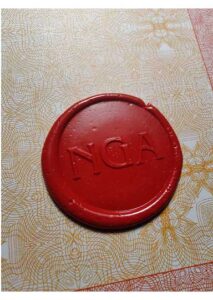
The wax seal is placed on in a glob. The letters “NGA” do not seem to correlate to anything noted anywhere else.
Part of the Provenance is typically included on the back of the artwork. Here, it looks like a very official gallery stamp. In an attempt to be more convincing, the address is of an actual gallery. But it is not named “Art Gallery New York.” It is called Agora Gallery. We conducted some quick research to see if there might have been an “Art Gallery New York” at one time located there, but we did not find anything. If this were the only shortfall in purchasing a piece of art, then it would be reasonable to continue with more investigation. However, this painting had already failed every step so far starting with its appearance – image not shown.
This is an attempt to put all the provenance on the back. Peter Max did create personalized works like this without additional provenance, usually including a quick sketch and a note to the person he was giving it to. After learning about Peter Max’s artwork in detail, turning the artwork over to authenticate it should not be an issue. But let’s say it is perfect and appears like a Peter Max, and you turn it over. Ok, the first thing to look at is his signature. Yes, he did use “Peter” at times. But with the “Max,” two things stick out. The “M” does not have three humps in his typical flowing style. When he used his first name in his signature, he tended to use separate letters, not the continuous style, when he only used “Max.”
This demonstrates another investigative technique. See what other Peter Max artwork the seller offers or has sold. It is far too coincidental to have two of the same type of “rare” Peter Max paintings. The only exception would be purchasing a Bonafide collection such as in an Estate Sale.
4. Examine the Artwork’s Quality and Materials
Peter Max’s original works often include textured, high-quality materials, whether canvas or archival paper. Forgeries may use cheap materials, causing a lack of depth and richness in the piece. Peter Max’s originals are known for their vivid, high-quality pigments that stand out in any lighting. Scrutinize the colors; authentic Max artwork will have vibrant and deeply saturated colors.
Bring a magnifying glass or use high-resolution photos to inspect the brushwork if possible. Peter Max’s brushstrokes are fluid and natural, creating a sense of movement. Machine-printed forgeries lack this texture and fluidity, often appearing flat when viewed closely.
Black Light Can Show A Lot!
Using a black light (UV light) can be particularly useful for authenticating Peter Max mixed-media pieces, as it helps pinpoint where he added hand embellishments to a base print if those enhancements aren’t immediately apparent. In Peter Max’s artwork—often layered on top of lithographs or serigraphs—any added paint typically fluoresces differently under UV than the printed areas, making it easier to see his brushstrokes or additional touches. Moreover, a black light can reveal repairs, touch-ups, or differences in paint types used over time, providing valuable insight into the piece’s history and authenticity.
5. Identify the Medium Used – It should be Acrylic Paint
Peter Max’s works are often done in acrylics on canvas, serigraphs, lithographs, and mixed media. If a seller claims an original painting is done in a medium Max rarely or never used, this should raise suspicion. For example, Max seldom used oil paint, so an oil painting would be highly unusual and warrant further investigation of some special circumstance or better yet just save your time. This can be very helpful to know and save you much investigation when any mention of it being a Peter Max oil painting. Here the seller saved us a lot of time by putting it in the title: “Peter Max – Amazing Oil Canvas – Signed – Stamped – 60cm X 40cm.”
Acrylic Paintings vs. Oil Paintings
To distinguish between an acrylic painting and an oil painting, start by examining the texture and surface of the artwork.
Acrylic paints dry quickly and often have a smooth, matte finish unless a gloss finish is used. Because acrylic paint is more transparent than oil paint, it can be layered to create texture and blended colors. However, Peter Max mostly painted one thick layer. Due to the stability of acrylic pigments, the colors tend to appear more vibrant and retain their intensity over time.
Oil paints take much longer to dry, resulting in a richer, more luminous appearance with subtle blending and softer color transitions. Oil paintings often have a glossy sheen and a noticeable texture, as the slower drying time allows for thicker applications and visible brushstrokes. A dead giveaway is that oil paintings smell much different because they contain linseed oil or other mediums, whereas acrylics are odorless. A closer inspection under magnification may reveal microcracks in older oil paintings, a feature not typically found in acrylics.
6. Questions to ask the seller
If the first five methods of identifying a fake Peter Max painting have passed the scrutiny and leave you reasonably satisfied, it is prudent to ask the seller the right questions for valuable insights and further conformation of the artwork’s legitimacy.
Start by inquiring, “How did you acquire the painting?” A legitimate seller should be able to provide a transparent and verifiable history of the artwork, such as whether it was purchased directly from a gallery, an auction, or through a reputable dealer.
“How long have you had the painting?” This can help determine if the seller has a genuine connection to the piece or if it was recently acquired, which could raise red flags.
“How did you establish the selling price?” If the price seems unusually low, an immediate “red flag” would be if it is under $1,000. This is a strong indicator that the work may be fake, as authentic Peter Max paintings are rarely, if ever, sold at bargain prices.
Other valuable questions include whether the seller has additional documentation (in addition to those mentioned in number 3 above). This could be a Bill of Sale or an art appraisal letter.
Ask about any repairs, alterations, or inconsistencies in the piece’s provenance. The answers to these questions can provide critical clues about the artwork’s authenticity and the seller’s credibility.
Most importantly, ask if the seller “guarantees” the authenticity (it’s best to have this in writing) and allows you to return the piece if you are unsatisfied.
Note that all MacDonald Gallery’s original artwork has a “Lifetime Investment Guarantee.”
7. Consult an Expert
After your successful evaluation, it would be prudent to consult an art appraiser or expert familiar with Peter Max’s work. Art appraisers or Max-certified experts can provide valuable insight into a piece’s authenticity. Some galleries offer authentication services and will typically inspect the artwork’s materials, provenance, and other characteristics to ensure legitimacy.
The ultimate peace of mind is to purchase only from reputable galleries or dealers with connections to the Peter Max Studio or authorized by his estate. Examples include PeterMax.com, Park West Gallery, Key West Gallery, Barterbys, and Off The Wall Gallery all of which are known for handling authenticated Peter Max works.
MacDonald Gallery would gladly provide a free consultation/opinion of any Peter Max artwork you are seriously considering purchasing or may have already purchased. See end of article.
Summary Checklist for Spotting Fake Peter Max Artwork:
- Familiarize yourself with Max’s themes and common elements.
- Carefully inspect the signature and look for a consistent style.
- Verify provenance and obtain at least a Certificate of Authenticity.
- Examine the materials, colors, and brushwork quality.
- Check that the medium used aligns with Max’s typical practices – Acrylic Paint.
- Get as much information as you can about the work from the seller.
- Consult an art expert or certified gallery for verification if in doubt.
BONUS Way to spot a Fake:
No matter what extravagant claims the seller makes to the artwork’s authenticity, whether it is signed or hand-painted, if you see something in the description or noted anywhere that says, “I sell this item in the style of the artist or as reproduction according to eBay rules, just like you can see in the pictures,” it’s a fake!
Furthermore, even though it is a common practice on eBay, it is not “according to eBay rules” as stated: “You may include the artist’s name in the title of the listing only when listing a work by the artist him/herself or an exact replica of the artist’s work. You may not include the artist’s name when listing a work done “in the style of” an artist.
By following these steps, you can better assess the authenticity of Peter Max’s artwork and ensure your collection contains only genuine pieces from this celebrated artist.
If you decide to go ahead with a “fake” Peter Max painting, maybe because you like the painting anyway, you will not have the pleasing feeling of owning an authentic work of art created by a master. It will always have a negative aura around it and an everlasting stench that stinks up the art world. Plus, it will have little resale value, and if you try to sell it, you risk a trafficking conviction, which could lead to a steep criminal penalty.
You may submit your request through our contact form below. Please provide a sales link to the painting, all available photos, and as much of the information listed in this article as you can.
MacDonald Gallery is happy to provide a free consultation/opinion of any Peter Max artwork you are seriously considering purchasing or may have already purchased.
Use the contact form below. Provide as much as you can of the following:
1. The title of the artwork if known or briefly describe the artwork.
2. Any links to the artwork (i.e. auction or sales links)
3. How you acquired or plan to acquire the work.
After submitting the form you will be able to attach photos and docs to our email response sent to you. Including: images of full artwork, Max signature closeup, various other close up images of painting, picture of back of canvas including close ups of any markings or labels, and if available Certificate of Authenticity, Appraisal, and/or bill of sale.
Click for more articles in Peter Max News.
Peter Max Artwork Reimagined
Through Juan Mira’s artistry, MacDonald Gallery has made it more accessible to own authentic Peter Max artwork and a hand-painted piece in one. Each work features a rare Peter Max lithograph print set within a hand-painted mat by Juan Mira, who expands the original image as an integrated painting. The result merges two creative visions into a single, vibrant composition — available in our Art and Paintings collection.
Lifetime Collector Guarantee applies to Originals and Mixed-Media works. © MacDonald Gallery, Adwin Blake, Curator.

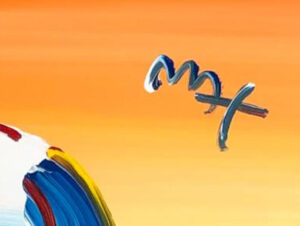
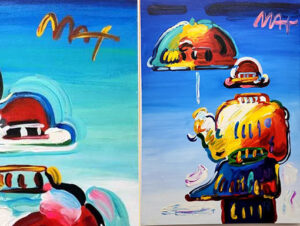
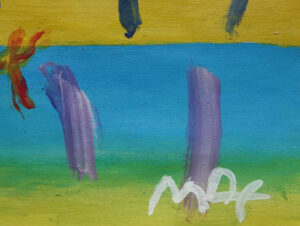
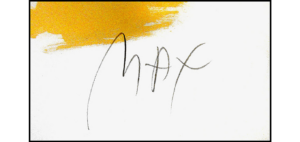
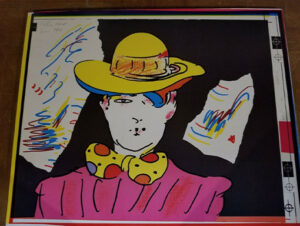
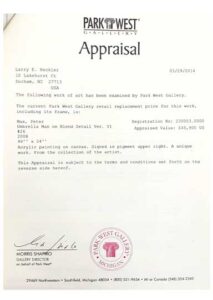
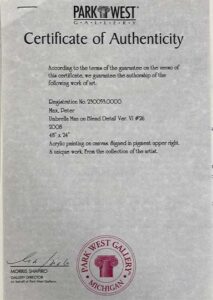
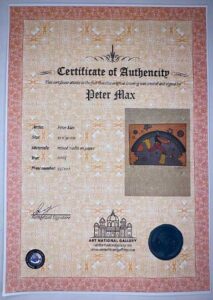
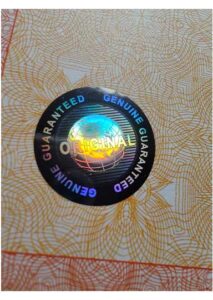
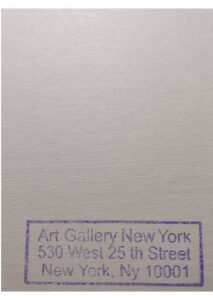
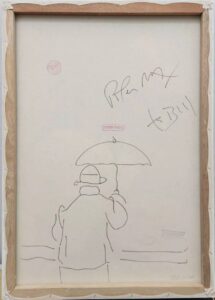
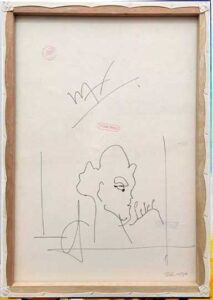
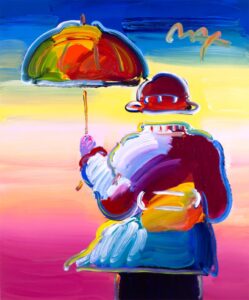
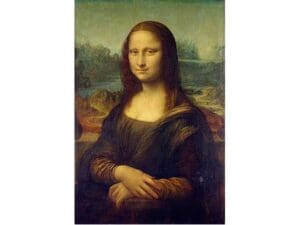
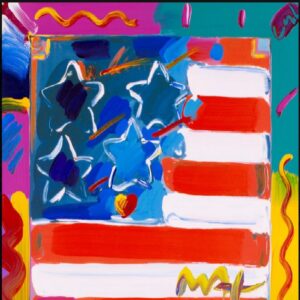
(taken from contact form)
Are you able to authenticate a Peter Max through photos? We are looking at purchasing from an estate sale and they can not provide the original certificate or sales receipt. Thank you. Allison
Dear Allison,
We cannot definitively authenticate a Peter Max through photos alone. However, based on the information you provide, we will gladly give you our opinion on the artwork’s authenticity.
The more photos, the better.
1. Full picture of artwork
2. Close-up of signature and any other writings
3. Close-up of any area that looks damaged or repaired
4. Back of artwork and close-up of writings, numbers, etc.
Other information that would be helpful from the seller include:
1. What happened to the Certificate of Authenticity and other paperwork?
2. When and where was the artwork purchased?
3. Provide any information on the seller, especially links to their business and the link to the artwork listing.
4. Name of the current owner (estate).
5. Does the current owner have additional Peter Max’s or other artworks?
Do you have physical access to see the artwork in person?
Thank you for letting us be a part of keeping Peter Max’s body of artwork authentic.
Artfully,
Adwin Blake
Curator
(see photos at end of article above)
Hello Mr. Blake,
Thank you for agreeing to take a look. The seller states that her brother passed and she has inherited the art. Based on our conversation, she does not care for the style of his collection and is, therefore, selling this portion of his estate. There is not a company involved.
Please see the attachments for her photos. I understand the photos are of low quality as the piece is framed behind glass. She states the back is enclosed except for the cut out showing the signature.
If you are of the opinion that further investigation is warranted, I will take the time to go in person to see the piece. However, if you deem it forged, I will save myself the four hour drive to her location.
Thank you,
Allison
Dear Allison,
It does not feel like an out-and-out fake, but there are a lot of questions.
“Sitting Angel” is not a very popular Max painting. The auction company that sold the original had to ask Max’s production assistant, Daniel White, what the painting’s title was—the original painting sold for $13,000.
Here are what you can take into consideration:
This “Sitting Angel” version appears to be a canvas print. I can’t tell for sure, but its quality may be suitable. A print on canvas is considered more valuable than a print on paper. However, all the Peter Max prints I know of are done on paper – not canvas.
1. It may have been sold through Peter Max & Company or authorization because the writing behind the cutout is much like it should be. However, there are some issues with the writing itself.
a. “10086” is the exact inventory number on the original. Typically, the inventory number changes, but most artworks like this are mixed media—meaning Max painted on top of a print. Note that I have verified that this image is an exact copy of the original. It does not appear that any paint was added to the print, but the pictures are unclear.
b. FYI, if paint were detected on top of the print, it would be worth further investigation because that would be considered mixed media—i.e., original, potentially adding thousands of dollars in value. The red flag is that this is a print on canvas, and I have not seen a Peter Max print on canvas being overpainted. His mixed media works are classified as “acrylic painting and color serigraphy or lithography on woven paper.”
c. The copyright “C” and “Peter Max” signature appear incorrect. Max used several different styles throughout his career. In 1990, the correct date for the painting, he did write out his full name with the copyright “C” in front of it. But here are the inconsistencies: The copyright “C” was usually written neatly. The “P” is close, but the “T” and second “E” don’t look like any Max I’ve seen. The “M” joining the “A” in Max is also unusual. No one was trying to copy his signature. It looks more like someone was trying to express their artistic flare without much regard for Max’s signature. Note that Peter Max did not always write this information as it is used for picture identification and copyright claims.
2. As for the cutout, it is common to have a cutout on the backside to display the Peter Max Studio registration number.
Positive Indications:
– This is not a very popular Peter Max image; someone knew the correct title.
– The writing behind the cutout is reasonable and a common practice.
– It is hard to tell, but the quality appears good.
– Whoever made this artwork had to have a good copy of the original to make a good print.
– It appears that the writing behind the cutout is actual writing, in which 1990 is the correct date of the original painting.
Negative Indications:
– No Certificate of authenticity or bill of sale.
– Canvas is not commonly used for Peter Max prints.
– The inventory number is somewhat suspicious because it is the same as the original. However, in the positive section, it should be noted that someone had to have inside information on the original serial number because it is not well-known.
– The back does not appear to be Peter Max’s signature.
Best Case to take into consideration:
– If this were a Peter Max mixed media painting, it would have a reasonable value and be worth having. Still, it would have to be officially authorized as a Peter Max mixed media to even approach the market value of an actual work.
– You need to weigh this information against the asking price and the eight hours there and back to decide if you want to take the next step.
Here are my recommendations if you want to proceed:
– See the painting in person.
– Examine the overall painting using common sense.
– Examine the image with a magnifying glass and a loupe
– Does there appear to be paint on top of the image? Very Important!
– Half-tone Screen Pattern – You will need to look very carefully with a loupe to see if you can see a printing half-tone screen pattern (see attached).
– If you believe there was paint on top of the image while looking at the screen pattern, it will be very apparent with a loupe—i.e., there will not be a screen pattern where there is paint.
– Inquire about other pieces of art her brother has and whether they have Certificates of Authenticity. It would be helpful if you could establish some credibility regarding the brother.
Lastly, since there is a lot of uncertainty here, but you like the “Sitting Angel” painting, I would like to present you with another option. However, I do not want to interfere with your proceeding with the investigation into “Sitting Angel.” I will continue helping you with any information I can provide.
Our artist, Juan Mira, paints similarly to Peter Max. Many Peter Max enthusiasts have his paintings; he has even painted representations of specific Peter Max paintings for private collectors. He could paint you a representation of “Sitting Angel.” He usually likes to put his twist on the painting, but on special request, he has painted the same Peter Max painting for collectors.
I am enthusiastic about Juan Mira and Peter Max, so I will keep this as short as possible. Juan Mira is significantly associated with Peter Max. Just Google “Juan Mira Peter Max,” and I will let that speak for itself. His bio is here: https://www.macdonaldgallery.com/juan-mira-american-pop-artist/
You will appreciate that all our artworks are registered and come with a Certificate of Authenticity, a Bill of Sale, and a Lifetime Investment Guarantee.
If you have any questions about anything art-wise or further authentication of “Sitting Angel,” please let me know.
Artfully,
Adwin
Dear Sir or Ma’am,
I work at an auction house and we are selling a Peter Max Texas flag acrylic painting this weekend. It appears authentic to me but the consignor did not have a COA, and purchased the piece from a now-closed Las Vegas gallery about 10-15 years ago for $15,000. There is a piece of masking tape on the back of the frame with the number 323454 and the framer, Randall’s Art and Framing. What other information might you need from me in order to provide an opinion of authenticity?